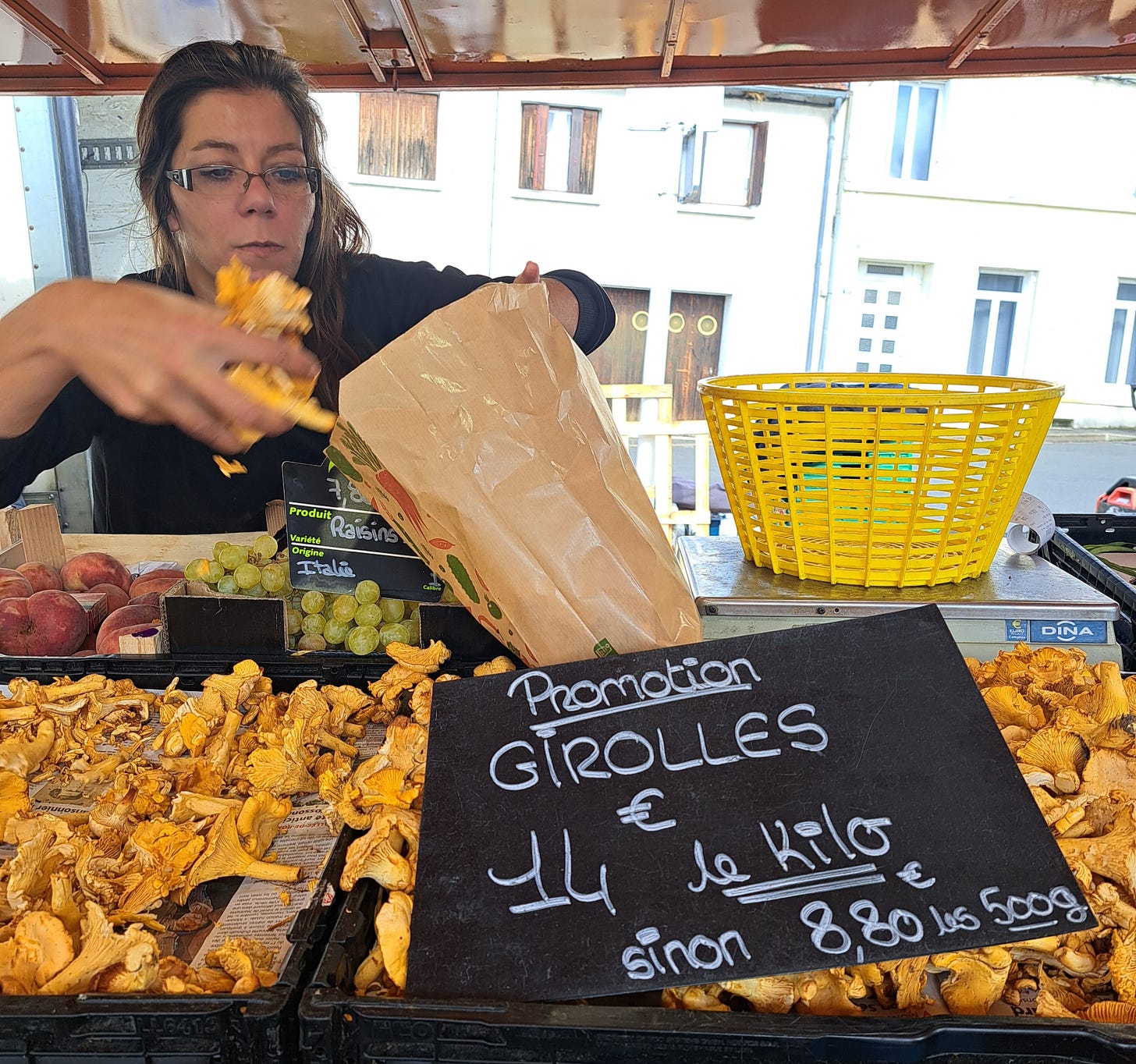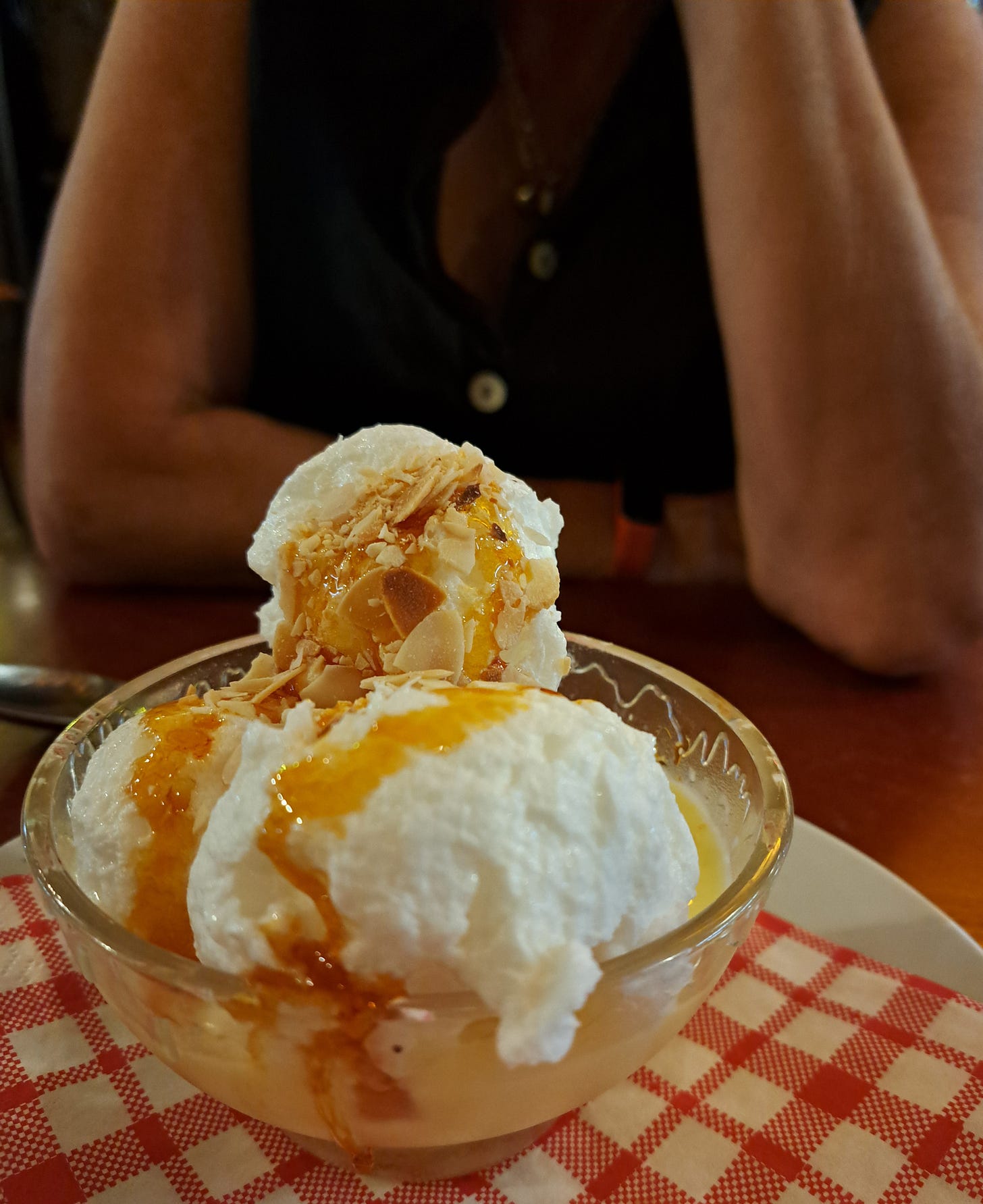How to shock an oyster
Three French markets, cat selfies, the theatre of holiday market shopping and what happens when spellchecker gets its way.
On my first morning in France, a grey eyed creature crept through the kitchen window, plopping softly onto the tiles, meowing malevolently for food. ‘His name is Bijou’ my friend Liz said.
‘He's not ours, he lives over the road but his owner is in hospital. He's not allowed in the lounge in case he has fleas.’ He instantly landed on my lap. I chanced it, falling for his Sher Khan kind of sneer, and I have no doubt, George Sanders inner voice. He managed to take a selfie of himself.
Liz has had her place in France for over 30 years. It's a little commune of its own, a collection of dwellings that at one time would have housed animals as well as humans. The old bread oven is still in place in its own building, now nursing a collection of bikes. The fireplace is huge, and her 1950’s kitchen unit has a drawer for baguettes. Ofcourse it does. An hour south of Tours in The Loire Valley, it's a farming area, fields full of sunflowers, maize and red sorghum, and there are food markets and farm shops everywhere.
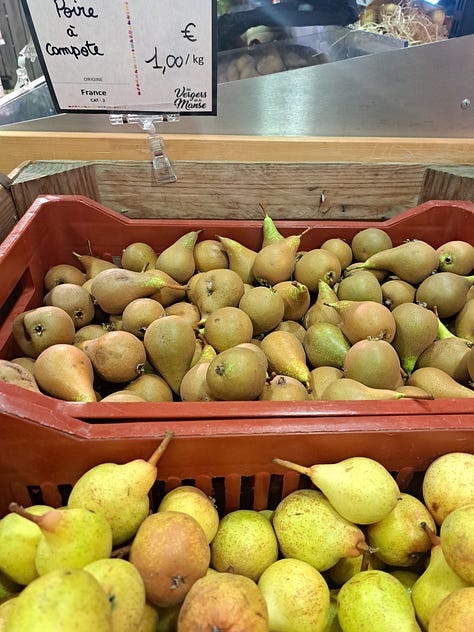
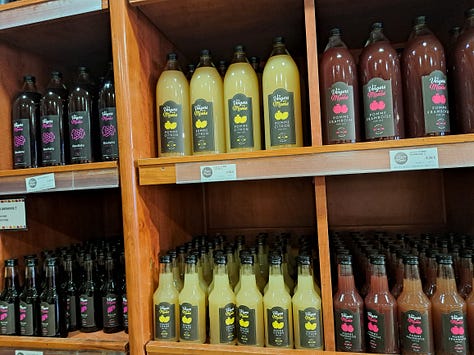

Les Vergers de la Manse are fruit growers, fruit and vegetables processors, makers of juices, vinegars, and preserves. They offer fruit bottling and pressing to other farmers and sell their range direct from their farm shop and into other shops in the area. Their range of juice flavours is impressive. I especially liked the apple and cassis. Amongst their crates of fruit, smaller apples and pears were labelled ‘for compote’ for a euro a kilo. Their shop is stocked with plenty of local specialities from mustards, sweets and biscuits, to grains, cold pressed local oil and locally made sorbets. A tub of their poire William sorbet came home with us.

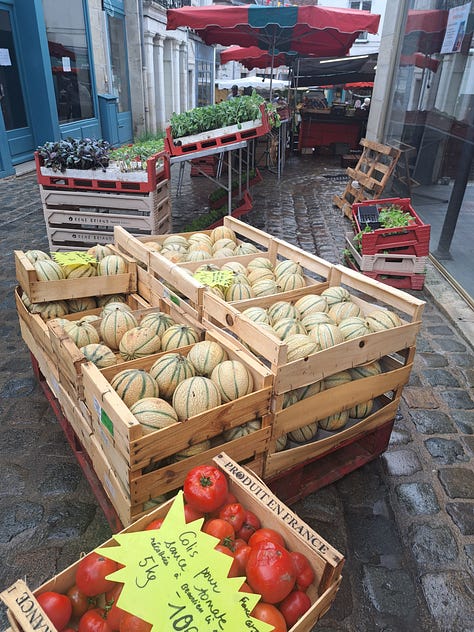
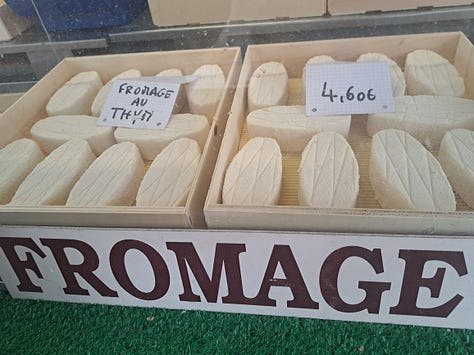

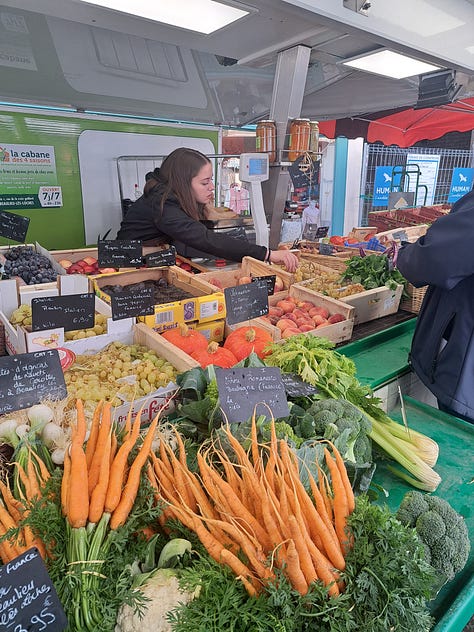
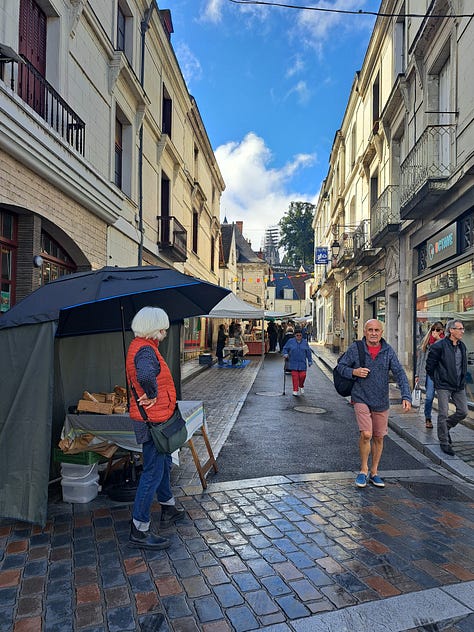
Loche market takes place every Wednesday and Saturday, up to a hundred stalls snaking through the pretty town centre, a seductive temptation at every corner. There's no grumbles from shopkeepers about market traders taking away their custom. Loches is crowded on market day, cafes and restaurants heaving. On this early September Saturday, a few stalls are away, the gaps on the streets like missing teeth, only too visible.
The only problem, as with any good market is how to shop without over buying, especially if we're thinking ahead, not just about dinner, but what to bring back home. Will the goats cheese survive the flight. Can peaches travel well, is it worth bringing back garlic. The produce on display is mostly French and seasonal. Purple plums and damsons, tiny golden mirabelles, green and deep red Reine Claude. Plump figs, bronze grapes from Provence, scented cantaloupe melons, apples, plaits of garlic, huge artichokes, craggy tomatoes, new carrots, and the first of the winter squash. If it’s French it’s clearly stated where it’s from, if not, the country of origin is displayed.
Customers carry old fashioned woven shopping baskets, without affectation. They queue at the butcher and fishmonger stalls, argue over which is the best cheese right now and yes, there are many on offer. This region is famous for its log shaped goats cheese with a rye straw through the middle: Saint-Maure-de-Touraine. We buy a seasonal sheep's milk cheese, Brebas du Lochois, flavoured with thyme.
The oyster man is back. He may have natives next week, but today he has 6 grades of rock oysters.
On a side street two men are selling accras de poisson, little fried fish balls. He gives us one to try: they're delicious, but seem quite expensive for E2.50 each. Liz is excited: her neighbour had told her to look out for them. It turns out that the price is for a generous bag full. I should have asked for the recipe; accras, also known as beignets de morue amongst many other names come from all sorts of places, including Trinidad, North Africa, Italy and Portugal.
We have to buy violet garlic ofcourse from the stall specialising in alliums. I'm on the lookout for sweet onions too. Friends have laughed at me for bringing them back, but it's almost impossible to find those huge sweet Spanish onions I remember from holiday salads in Spain and Portugal. Bring back whatever you like, custom rules allowing, and don't let anyone put you off. I have an expandable suitcase for just this reason.

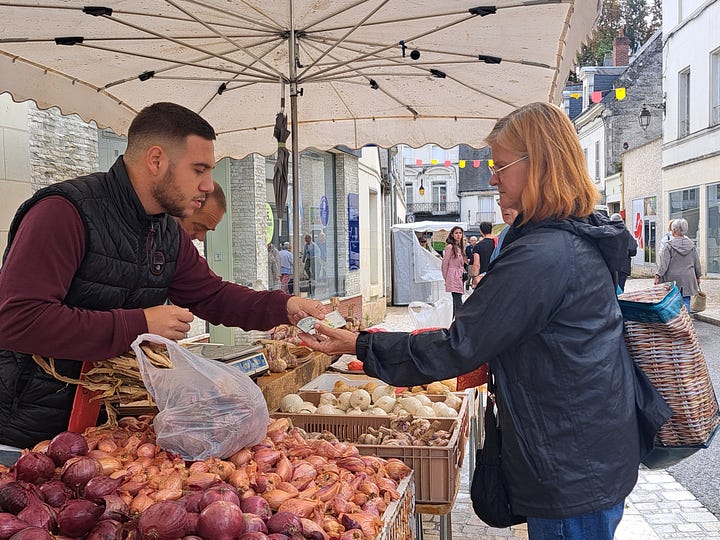
Liz has been telling me about a memory of a platter of fruits de mere, when she watched some of her shellfish shuffle off her plate. We’re at the fish stall and there are the culprits, live winkles (bigorneaux in French.) We buy a bream to cook very simply in the oven. I don't think that winkles are on tonights menu, and I have oysters to open.
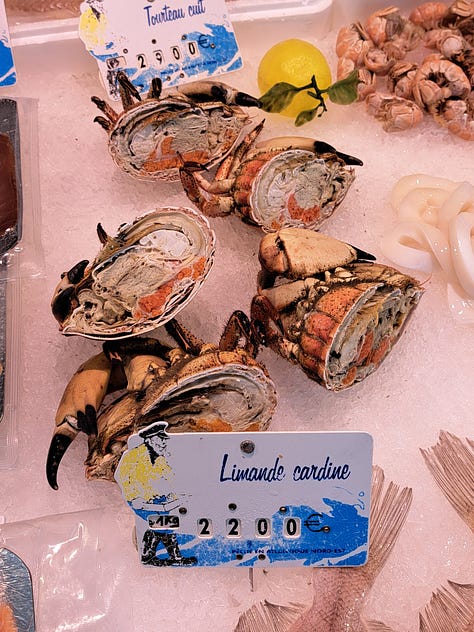
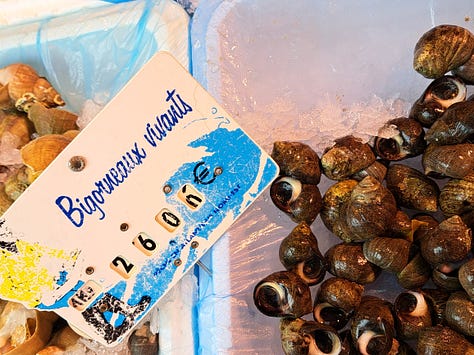
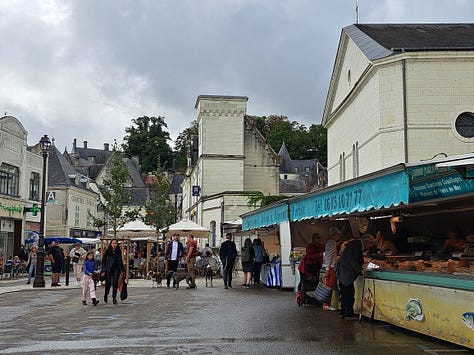
In my very first substack piece I wrote about holiday food markets, how we embrace them and love them, mostly from a distance, walking through, maybe buying a baguette. When we return home, we're back to our supermarket routines.
Markets are part of the holiday experience, novelty, memory, sensory overload, and whether it's piles of spices or serpentine squash, we take pictures home rather than trade with stall holders, we don't need anything, we just did a big supermarket shop. The market forms a theatrical backdrop, a scenic promenade performance with no standing ovation.
Stall holders seem to know that you're not in the market to buy. Maybe the camera or lack of shopping bags gives it away. Perhaps you want to buy but you don't know the language. A smile goes a long way. I'm not the best linguist but I try to learn how to ask for 100 grams or a half kilo.
Back home many markets never seem the same. You're no longer on holiday. The light's been turned off, the sky is grey, and everything is being sold in anonymous bowls.
There are things we think we should do because it's part of the holiday package, in the moment. Markets fit the bill. I can't resist returning to theatrical metaphors. The overture before the curtain goes up. A frisson of excitement.
Act one, arriving, finding a place to park. Nearly leaving because there is no parking, whilst swearing at two dogs, a parking attendant and the person in the fiat who got the spot you were waiting for. Finally finding a place, walking a mile to the market.
What do you know about your market? You may have read a few reviews, hopefully not trip advisor, which urgently needs a review of its reviewers. You're going in blind. You don't know where the market starts or ends, what to look for, unless you've researched the area's specialities, in which case you're probably asking yourself, am I going to be ripped off because all the tourists want to buy the same thing.
Act two. You're working your way through a crowded length of stalls. You may have a child or two languishing at the tail end, until ice-cream is promised, or a cafe with Wi-Fi so they can catch up with their mates or ticktok (they've been a whole 24 hours away).
Act three. Quite likely one of you is happy to continue to wander, whilst another is dropping hints about leaving because after all, you don't really need anything and it's all more expensive than the supermarket.
Intermission. Finding a cafe that has Wi-Fi, serves local food, isn't too expensive, has a free table outside. You settle for anywhere with a free table.
Act four. Deciding between stall A and stall B whilst everyone else in your party is getting grumpy. You send them back to the cafe.
Act 5. Finally buying something. Happy because you were understood, you buy more than you expected, and walk away with your purse considerably lighter because having tasted your purchase, you couldn't say no.
Curtain.
Reviews and discussion. Was it worth going to, would you recommend it? Haven't we all all had similar experiences to this.
I try to aim for markets that cater for local people, not tourists. In London this means avoiding Borough market which is often the only food market visitors know about and yes, it's FULL of tourists, taking photos, queuing for over-priced paella. It's not a pleasant experience. There are a few decent food shops, restaurants and stalls in Borough; if you have to go, go early.
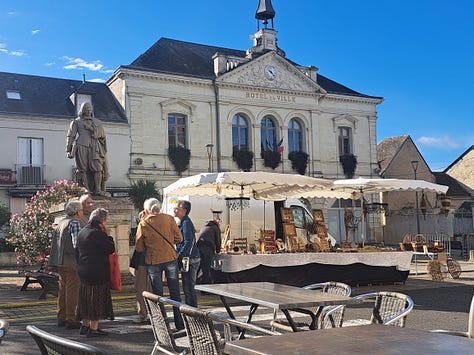


In France it's a sunny Sunday morning. We’re heading to the market in Descartes, birthplace of its namesake mathematician and philosopher.
A statue of the man himself looks down on the market stalls in the small town. The market itself isn't large but it brings out the local community, many of whom are sitting at tables outside the cafes near the statue. There are queues for the meat and charcuterie stall, goats cheese and bread stalls. A few stalls including one selling plants, flowers and vegetable seedlings we saw on Saturday in Loches.
At a stall advertising cockerels and rabbits for sale, two elderly men in flat caps, unmistakably brothers are selling eggs to a customer. I can't help thinking about who will take over when farming becomes too much for them. I hope they have someone to hand it on to. I hope they never give up.
A fruit and vegetable stall has fresh girolles for E14 a kilo. On the Natoora website, they're £50 a kilo.
‘Did you mean to say shock?’
Liz and I are sitting in front of an open fire on my last evening in France. She's reading the short piece I've just posted on Substack and apparently I've been shocking oysters. ‘Easily done' I say, ‘they probably weren't too happy being disturbed from their cosy beds.’
I was so proud of myself for remembering how to open oysters properly, to go for the muscle at the tip to loosen, and hold the right way up, to keep the liquid, or most of it intact. I'm glad there's an oyster knife here. I may even have bought it, thinking back to opening up a dozen without the aid of the correct tool. Hands up if you've done the same, going through every implement in your kitchen, and finally reverting to the tool chest. I'm sure that a chisel came into play. It wasn't pretty.
The next day, luggage in tow, our bus arrives in Tours, capital of the Loire Valley at 12.30pm, just when the street markets close. The covered market is supposed to be open all day. We reach it about 1pm and find that most of the stalls are closed. So are the restaurant stalls that are meant to be there. A good lesson in web research, it’s often not accurate. We look around the few stalls that are open; cheese, fruit and vegetables, meat and charcuterie, then make our way to the old town to find a restaurant that’s still open. As many of you will know, that’s not easy in France after 1pm. The first few places we try say no, they’re closed. It’s around 1.30pm.
We find an old bouchon in the back streets that miraculously is still serving. Its menu is full of traditional dishes from coq au vin du chinon, using the local Loire wine, to Iles flottantes (floating island). When I return to the covered market an hour later, the stalls are opening up.
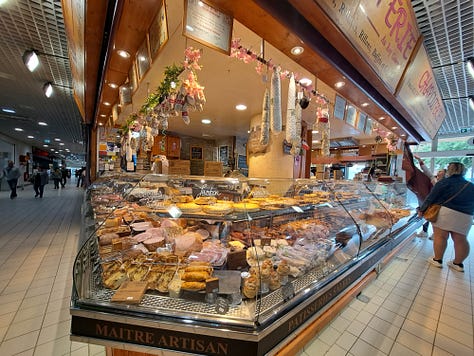


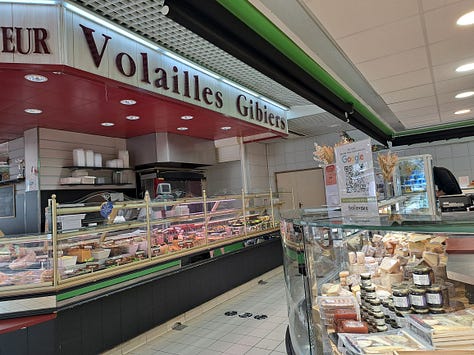

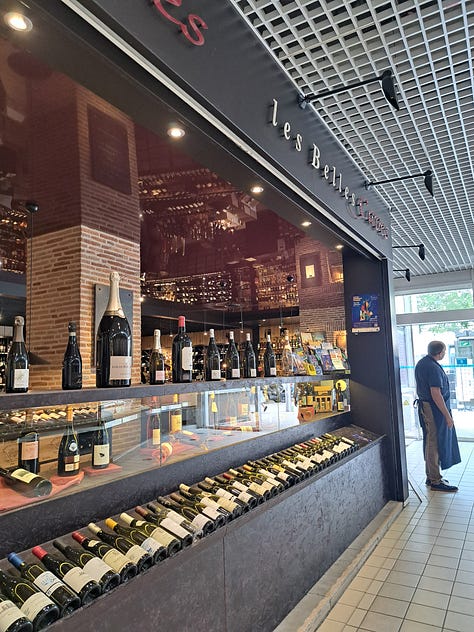
Wine, two or three more cheese and dairy stalls, butchers, fishmongers, chocolates, spices and patisserie. Lesson learnt. I should have remembered from other destinations that just because a covered market says it’s open all day, don’t assume that means that all the stalls will be available. It’s fine though. I’ve bought cheese; I can’t possibly squeeze anything else into my luggage. Tomorrow is another day.
All my posts are reader supported and you make it happen. To support my work please do consider becoming a paid subscriber. It’s just like buying a book, one chapter at a time. If you can’t manage that, if you hit the HEART at the top or bottom of this post, it makes it easier for people to find this newsletter, and it also makes me very happy!









